HIV membrane fusion
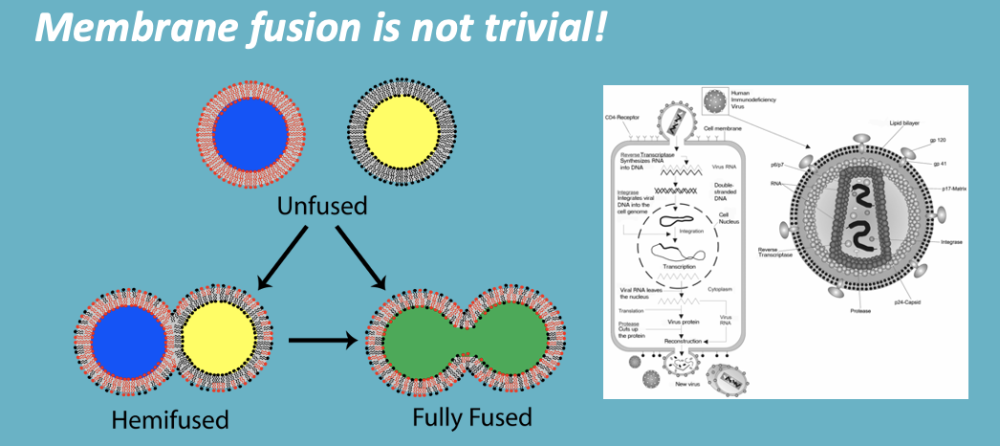
- HIV is enveloped virus (membrane)
- most viruses are enveloped (covid, flu, etc.)
- membrane must fuse w/ membrane that encloses our cell
- must fully fuse w/ cell it wants to infect
specific interactions btw HIV gp120 protein
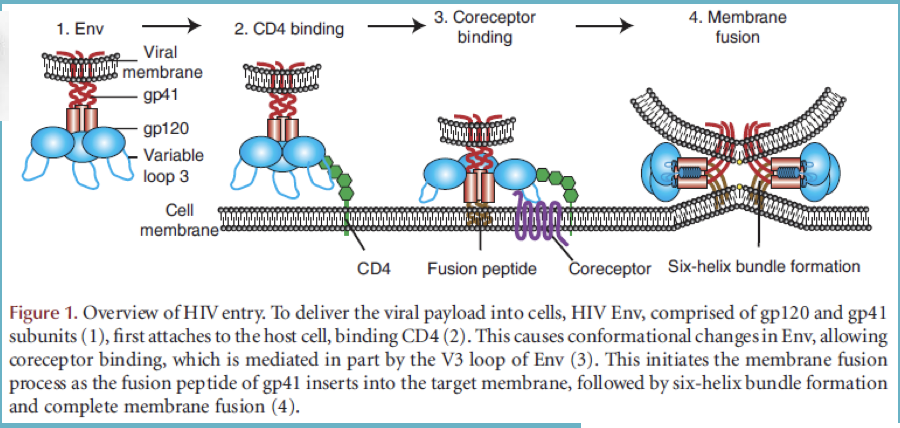
specific interactions btw HIV gp120 protein and T-cell CD4 for initial attachment of HIV to T cell
-> and then subsequently CCR5 (coreceptor) that is required for membrane fusion
gp120 protein is on surface
- viral protein (on HIV) responsible for attaching to cell + getting membranes to fuse
- 2 steps:
- initial attachment
- subsequent infusion
- gp120 evolved to bind to CD4 (high affinity, bind tightly) = HIV tethers to cell
- upon contact, gp120 change structure to bring viral particle closer to cell surface (reorganization means proteins become much closer)
- gp120 also binds coreceptor AFTER binding to CD4
- these 2 (gp120 to CD and to coreceptor) = drive fusion of the cells
summary of last slide
gp120 +CD4, reorganization of gp120 + coreceptor binding -> membrane fusion = now complete membrane fusion
now talking abt late phase
early phase done when DNA incorporate into host cell chromosomes = late phase
in late phase
- replicate self: genes expressed into RNA and -> viral proteins = forms progeny virus (new viruses
make note for this link:
https://www.youtube.com/watch?v=odRyv7V8LAE
...
HIV expresses "polyproteins" that must be
cut up by the HIV protease (OR) into their individual components
- during late phase of infection cycle, HIV proteins (including reverse transcriptase and integrase) are initially made as "beads on a chain" that have to be freed from one another (protease, scissor, cuts it) to become functional
what enzyme cuts the HIV proteins in order for them to become functional?
protease
in order to make infective virions
once protease cuts proteins to become functional, they are then
infective virions.
HIV can infect
many types of cells, but particularly infects CD4/coreceptor cells very easily
humans became aware of HIV in ___ but it had been killing ppl for 60 years prior
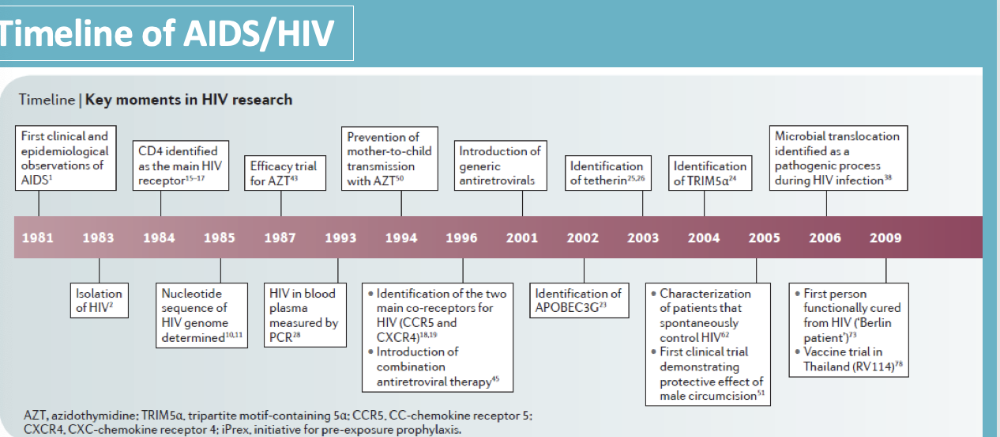
1981
reported 5 young men had unusual infection. There were clusters of unusual/uncommon cases being reported.
initial recognition of disease: AIDS in the US
1981
1st global indication of HIV
June 5
- June 5, CDC published weekly report describing cases of rare lung infection, PCP (pneumocytis carinii pneumonia) in 5 young, previously health, gay men
- all the men had other unusual infections
- this indicated their immune systems were not working
- first official reporting of what would become known as AIDS epidemic
June 6
- doctors around US flood CDC w/ reports of similar uncommon cases (opportunistic infections)
these indicated problems with immune systems (suspected issue)
- confirmed later that year, study published saying 4 patients suffering from infection analyzed, reported that LEU3 (T helper cells) were MUCH lower (0 or almost 0) than healthy individuals (42 ish), and other immune cell levels were also very low
- indication of immune system issue, realized it was t helper cells (CD4+ cells)
end of 1981
- now knew what was going on w/ immune system
- still no idea what was causing disease
- took 2 years to find out what was causing immunosuppression
- partially bc retroviruses were discovered recently (in 70s). They were new and didnt know many human diseases caused by them. they did not expect it to be caused by retroviruses
identifying the cause of this immuno-suppression
3 initial hypotheses
link doesnt work
https://jamanetwork.com/learning/audioplayer/16634751?widget=personalizedcontent&previousarticle=16653636
identifying cause of AIDs
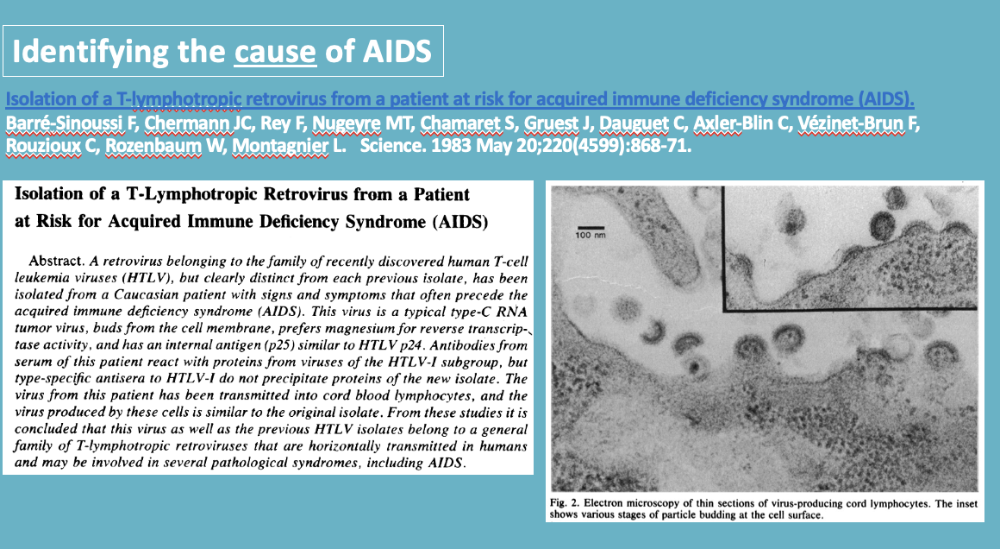
1983 breakthrough
isolated it
removed blood from person w/ HIV, cultured, visualized cells, saw the HIV virions emerging from cells (see budding in picture)
essay - nobel biographical essay, francoise barre-sinoussi and luc montagnier won 2008 nobel prize for discovering HIV
http://www.nobelprize.org/nobel_prizes/medicine/laureates/2008/barre-sinoussi-bio.html
- 1892, meetings about how observations suggestion disease attacked immune cells, but strong depletion of CD4 lymphocytes greatly hindered isolation of virus from rare cells in patient with AIDS
- lymph node biopsy from patient w/ lymphadenopathy
- waited until new year to obtain first patient biopsy from which lymphocytes isolated + cultured
- tested for reverse transcriptase activity
- detected weak enzymatic activity which increased significantly a few days later
- reverse transcriptase activity level dropped dramatically as T lymphocytes were dying
- added lymphocytes from blood donor to cell culture -> virus started to infect newly added lymphocytes + detected reverse transcriptase activity again
- named newly isolated virus: lymphadenopathy associated virus (LAV)
- isolated, amplified, characterized
- ...
HIV and AIDS
- HIV is the infectious agent (virus)
- causes slow decline of immune system
- AIDS - end stage of HIV infection when a characteristic spectrum of opportunistic infections or cancers takes advantage of the weakened (or eroded) immune system
HIV
human immunodeficiency virus
the infectious agent (virus)
causes slow decline of immune system
AIDS
acquired immunodeficiency disease syndrome
AIDS - end stage of HIV infection when a characteristic spectrum of opportunistic infections or cancers takes advantage of the weakened (or eroded) immune system
having HIV does NOT mean necessarily have AIDS
now, most ppl dont have AIDS anymore
how does HIV cause AIDS?
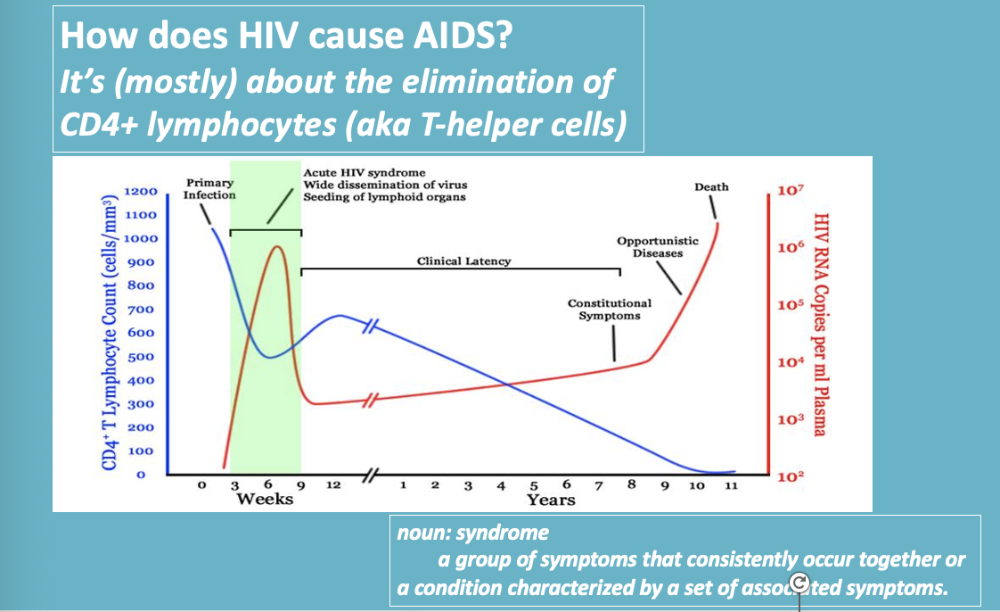
- mostly about elimination of CD4+ lymphocytes (T helper cells)
Red – level of HIV in blood
- infected -> viral levels very high (acute phase)
- feels like bad flu
- eventually, if immune system working well, bring down infection
- don’t get rid of phase
- individual enter asymptomatic phase (clinical latency) - no signs of infection
- person feels normal
- asymptomatic stage can last years
Eventually, person becomes susceptible to many types of infection
- opportunistic pathogens -> pathogens that don’t normally hurt if have good functioning immune system
- types of diseases first described. The unusual infections found bc their immune systems were low
Ppl succumb to opportunistic infections
HIV = primary infection -> leads to secondary (opportunistic) infections that are the cause of death
Untreated – can last 4/5 years
Blue – levels of T helper cells
- normal – 1000 cells/million cells
- intial drop during acute phase = normal
- but CD4 counts do
NOT return to normal after acute phase
- in diff individuals, have diff levels after acute phase. Higher the better
- usually return to level that allows immune system to be relatively normal
- over years, levels drop bc the cells are targeted by HIV
Aids = acquired immune deficiency syndrome
Syndrome – disease state, grouping of symtpsoms
Use bc individuals can die of different things (depends on particular opportunistic infection)
syndrome
group of symptoms that consistently occur together or a condition characterized by a set of associated symptoms
how CD4+ T helper cells contribute to various immune system activities
- if erase these, reduce effectiveness of other immune cells
- Tregs
- suppresses tumor immunity
- promotes immune intolerance
- maintains lymphocyte homeostasis
- Th1
- promotes tumor immunity
- intracellular pathogens
- drives autoimmunity
- Th2
- extracellular pathogens
- allergy
- asthma
- Th17
- controversial tumor immunity
- breaks immunity tolerance
- extracellular bacteria
- autoimmunity
opportunistic infections and their relationship to HIV/AIDs
https://www.aids.gov/hiv-aids-basics/staying-healthy-with-hiv-aids/potential-related-health-problems/opportunistic-infections/
https://jamanetwork.com/learning/audio-player/16634751?widget=personalizedcontent&previousarticle=16653636
Understand what a ‘Case Control’ study is and why is was so important.
The reaction at a White House Press conference following the mention of a ‘gay plague’.
“HIV is certainly character-building. It’s made me see all of the shallow things we cling to, like ego and vanity.
Of course, I’d rather have a few more T-cells and a little less character.”